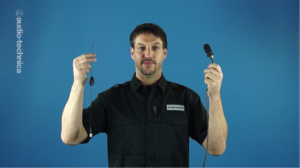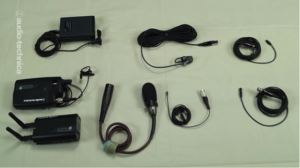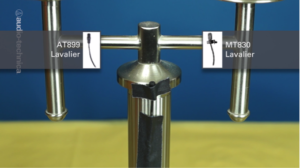In this installment of our blog series on Basic Audio Techniques for Video we’ll explain how to select the proper lavalier microphone for filming. If you missed the previous installment explaining how to use the tie bar, you can read it here.
Lavalier Basics
Over the past fifty years, lavalier microphones have evolved, from wearing small dynamic microphones around our neck on a cord to using ultra small condenser-type microphones no bigger than a strand of spaghetti.

Some tend to judge lavalier mics based on size rather than their individual performance. However, today’s modern models are all small enough to be hidden quite easily, so it’s far more important to focus on the pickup pattern and effective reach of the microphone.
Lavalier microphones can be divided into two groups: those that sound natural regardless of distance (transparent), and those that enhance and emphasize the voice close-up (proximity). The best way to differentiate between the two groups is to simply listen to the microphones. Start by holding the lavalier up to your chest and begin speaking. Continue talking while slowly moving the microphone further away. If there’s a noticeable drop off in fullness and volume after just a foot or two, it’s a proximity lavalier. Transparent lavaliers will show a slight decrease in volume, but will retain its overall tonal quality even when placed a full arm’s length away.
Proximity Lavaliers
Some lavaliers like the AT803 can isolate talent from the background and often emphasize the voice, providing a rich, announcer feel. These mics have less reach, so it’s necessary to rig them higher up on the chest or lapel, ensuring they are no more than several inches from the talent’s mouth.

Proximity lavaliers are a mainstay among radio and television broadcasters. They are excellent for news anchors, interviews, lectures, studio television, and anywhere there is a need to isolate talent from the surrounding environment.

Transparent Lavaliers
On the opposite end of the spectrum are microphones that provide a much more natural sound. They’re referred to as transparent lavaliers because they sound so natural that the audience feels like they are transparently eavesdropping on the talent.
While some microphones will emphasize vocals but drop in volume when moved a few inches from the talent, transparent lavaliers show a very gradual taper over a few feet of distance, with just a slight increase of room noise.

Because they can cleanly pick up dialog from several feet away, filmmakers often use these microphones as planted mics hidden in the set. The AT899 and MT830 can capture quality dialog from four or five feet away.
Pickup Patterns
When selecting a lavalier microphone it’s also important to take pickup pattern into consideration. Lavaliers can either be omnidirectional, picking up equally well in all directions, or unidirectional (also known as cardioid).
Cardioid microphones have a definite front and back and always need to be pointed directly towards your talent’s mouth. Cardioid lavaliers are ideal for live lectures and presentations, as they reduce audience noise and limit feedback. These mics are also good for broadcast studio situations, especially radio, where talent doesn’t move around too much and you’re not concerned about seeing the mic.
When mounting a cardioid lav, place it at the center of the chest or lapel and angle it slightly towards the mouth. Typically, presenters are wearing business attire that can properly support the weight of a mic clip without it sagging.

For most film and video applications, it’s best to use an omnidirectional lavalier. Tie bars can tilt if attached to loose clothing, especially when rigging more active talent. However, since omnidirectional lavs pick up well regardless of their direction, they don’t need to be lined up with the mouth. You can get creative with your rigging, mounting to a collar, shoulder straps, hats, eyeglass frames and even in hair. The angle of the microphone is not important; the only limitation is distance.
These basic rules will help you choose the right lavalier for any situation.